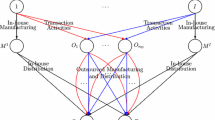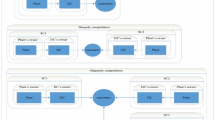Abstract
In this paper, we construct a supply chain network model with information asymmetry in product quality. The competing, profit-maximizing firms with, possibly, multiple manufacturing plants, which may be located on-shore or off-shore, are aware of the quality of the product that they produce but consumers, at the demand markets, only know the average quality. Such a framework is relevant to products ranging from certain foods to pharmaceuticals. We propose both an equilibrium model and its dynamic counterpart and demonstrate how minimum quality standards can be incorporated. Qualitative results as well as an algorithm are presented, along with convergence results. The numerical examples, accompanied by sensitivity analysis, reveal interesting results and insights for firms, consumers, as well as policy-makers, who impose the minimum quality standards.







Similar content being viewed by others
References
Akerlof GA (1970) The market for ‘lemons’: quality uncertainty and the market mechanism. Quart J Econ 84(3):488–500
Baltzer K (2012) Standards vs. labels with imperfect competition and asymmetric information. Econ Lett 114(1):61–63
Besanko D, Donnenfeld S, White LJ (1988) The multiproduct firm, quality choice, and regulation. J Ind Econ 36(4):411–429
Burnetas A, Gilbert SM, Smith CE (2007) Quantity discounts in single-period supply contracts with asymmetric demand information. IIE Trans 39(5):465–479
Cachon G (2003) Supply chain coordination with contracts. In: Graves S, de Kok F (eds) Handbooks in operations research and management science: supply chain management, vol 11, Handbooks in OR & MS, North Holland, Amsterdam, The Netherlands, pp 229–339
Chen F (2003) Information sharing and supply chain coordination. In: Graves S, de Kok F (eds) Handbooks in operations research and management science: supply chain management, vol 11, Handbooks in OR & MS, North Holland, Amsterdam, The Netherlands, pp 341–421
Corbett C, Zhou D, Tang C (2004) Designing supply contract: contract type and asymmetric information. Manag Sci 50(4):550–559
Cournot AA (1838) Researches into the mathematical principles of the theory of wealth, English translation. MacMillan, London, England
Dafermos S, Nagurney A (1987) Oligopolistic and competitive behavior of spatially separated markets. Reg Sci Urban Econ 17:245–254
Dupuis P, Nagurney A (1993) Dynamical systems and variational inequalities. Ann Oper Res 44:9–42
Esmaeili M, Zeephongsekul P (2010) Seller–buyer models of supply chain management with an asymmetric information structure. Int J Prod Econ 123(1):146–154
Gabay D, Moulin H (1980) On the uniqueness and stability of Nash equilibria in noncooperative games. In: Bensoussan A, Kleindorfer P, Tapiero CS (eds) Applied stochastic control in econometrics and management science. North-Holland, Amsterdam, The Netherlands, pp 271–294
Gilmore HL (1974) Product conformance cost. Qual Progress 7(5):16–19
Giraud-Heraud E, Soler L-G (2006) Retailers’ supply chain, product differentiation and quality standards. In: Ondersteijn CJM, Wijnands JHM, Huirne RBM, van Kooten O (eds) Quantifying the agri-food supply chain. Springer, The Netherlands, pp 67–83
Gray JV, Roth AV, Leiblein MV (2011) Quality risk in offshore manufacturing: evidence from the pharmaceutical industry. J Oper Manag 29(7–8):737–752
Hasija S, Pinker EJ, Shumsky RA (2008) Call center outsourcing contracts under information asymmetry. Manag Sci 54(4):793–807
Hogenau B (2013) US manufacturers gain edge over foreign competition with quality and sustainability initiatives. Environ Protect. http://eponline.com/articles/2013/01/11/us-manufacturers-gain-edge-over-foreign-competition-with-quality-and-sustainability-initiatives.aspx
Juran JM, Gryna FM (1988) Quality control handbook, 4th edn. McGraw-Hill, New York
Lee CY, Yang R (2013) Supply chain contracting with competing suppliers under asymmetric information. IIE Trans 45(1):25–52
Leland HE (1979) Quacks, lemons, and licensing: a theory of minimum quality standards. J Polit Econ 87(6):1328–1346
Lutz MB, Lutz S (2010) Pre-emption, predation, and minimum quality standards. Int Econ J 24(1):111–123
Mishra BK, Raghunathan S, Yue X (2009) Demand forecast sharing in supply chains. Prod Oper Manag 18(2):152–166
Masoumi AH, Yu M, Nagurney A (2012) A supply chain generalized network oligopoly model for pharmaceuticals under brand differentiation and perishability. Transport Res E 48:762–780
McDonald B (2013) A fresh look at a dirty problem. Food Qual Saf Mag. http://www.foodquality.com/details/article/834893/A_Fresh_Look_at_a_Dirty_Problem.html
Nagurney A (1999) Network economics: a variational inequality approach, second and revised edition. Kluwer Academic Publishers, Boston
Nagurney A (2006) Supply chain network economics: dynamics of prices, flows, and profits. Edward Elgar Publishing, Cheltenham
Nagurney A (2010a) Optimal supply chain network design and redesign at minimal total cost and with demand satisfaction. Int J Prod Econ 128(1):200–208
Nagurney A (2010b) Formulation and analysis of horizontal mergers among oligopolistic firms with insights into the merger paradox: A supply chain network perspective. Comput Manag Sci 7:377–410
Nagurney A, Dupuis P, Zhang D (1994) A dynamical systems approach for network oligopolies and variational inequalities. Ann Reg Sci 28:263–283
Nagurney A, Li D (2013) A dynamic network oligopoly model with transportation costs, product differentiation, and quality competition. Comput Econ. doi:10.1007/s10614-013-9387-6
Nagurney A, Li D, Nagurney LS (2013a) Pharmaceutical supply chain networks with outsourcing under price and quality competition. Int Trans Oper Res 20(6):859–888
Nagurney A, Li D, Wolf T, Saberi S (2013b) A network economic game theory model of a service-oriented Internet with choices and quality competition. Netnomics 14(1–2):1–25
Nagurney A, Li D, Saberi S, Wolf T (2013c) A dynamic network economic model of a service-oriented Internet with price and quality competition. In: Invited paper for network models in economics and finance conference volume, Athens, Greece. Springer, Berlin
Nagurney A, Nagurney LS (2012) Medical nuclear supply chain design: a tractable network model and computational approach. Int J Prod Econ 140(2):865–874
Nagurney A, Wolf T (2013) A Cournot–Nash–Bertrand game theory model of a service-oriented Internet with price and quality competition among network transport providers. Comput Manag Sci. doi:10.1007/s10287-013-0183-5
Nagurney A, Yu M (2012) Sustainable fashion supply chain management under oligopolistic competition and brand differentiation. Int J Prod Econ 135:532–540
Nagurney A, Zhang D (1996) Projected dynamical systems and variational inequalities with applications. Kluwer Academic Publishers, Boston
Nash JF (1950) Equilibrium points in n-person games. Proc Natl Acad Sci USA 36:48–49
Nash JF (1951) Noncooperative games. Ann Math 54:286–298
Ren ZJ, Cohen MA, Ho TH, Terwiesch C (2010) Information sharing in a long-term supply chain relationship: the role of customer review strategy. Oper Res 58(1):81–93
Ronnen M (1991) Minimum quality standards, fixed costs, and competition. RAND J Econ 22(4):490–504
Saberi S, Nagurney A, Wolf T (2013) Price and quality competition in a service-oriented Internet. Isenberg School of Management, University of Massachusetts Amherst
Shapiro C (1983) Premiums for high quality products as returns to reputations. Quart J Econ 98:659–679
Smith G (2009) Interaction of public and private standards in the food chain. OECD Food, Agriculture and Fisheries Papers, No. 15, OECD Publishing. http://dx.doi.org/10.1787/221282527214
Spence M (1973) Job market signaling. Quart J Econ 87(3):355–374
Spence M (1975) Monopoly, quality, and regulation. Bell J Econ 6(2):417–429
Stiglitz JE (1987) The causes and consequences of the dependence of quality on price. J Econ Lit 25(1):1–48
Thomas K (2013) Lapses in big drug factories as to shortages and danger. The New York Times
Thomas DJ, Warsing DP, Zhang X (2009) Forecast updating and supplier coordination for complementary component purchases. Prod Oper Manag 18(2):167–184
Tirole J (1988) The theory of industrial organization. MIT Press, Cambridge
Wankhade L, Dabade B (2010) Quality uncertainty and perception, information asymmetry and management of quality uncertainty and quality perception. Springer, Berlin
Xu H, Shi N, Ma SH, Lai KK (2010) Contracting with an urgent supplier under cost information asymmetry. Eur J Oper Res 206(2):374–383
Yu M, Nagurney A (2013) Competitive food supply chain networks with application to fresh produce. Eur J Oper Res 224(2):273–282
Zhang D, Nagurney A (1995) On the stability of projected dynamical systems. J Optim Theory Appl 85:97–124
Zhou YW (2007) A comparison of different quantity discount pricing policies in a two-echelon channel with stochastic and asymmetric demand information. Eur J Oper Res 181(2):686–703
Acknowledgments
This research was supported, in part, by the National Science Foundation (NSF) grant CISE #1111276, for the NeTS: Large: Collaborative Research: Network Innovation Through Choice project awarded to the University of Massachusetts Amherst. This support is gratefully acknowledged. The first author also thanks the organizers of the 10th International Conference on Computational Management Science held on Montreal, Quebec, Canada, May 1–3, 2013 for discussions with participants that led to this work. The authors also thank the Guest Editor of this special issue for the opportunity to publish this work. This paper is dedicated to Professor Berc Rustem to thank him for his highest of standards, dedication, leadership, and vision as a scholar and as the Editor of the journal Computational Management Science over many years.
Author information
Authors and Affiliations
Corresponding author
Rights and permissions
About this article
Cite this article
Nagurney, A., Li, D. Equilibria and dynamics of supply chain network competition with information asymmetry in quality and minimum quality standards. Comput Manag Sci 11, 285–315 (2014). https://doi.org/10.1007/s10287-014-0216-8
Received:
Accepted:
Published:
Issue Date:
DOI: https://doi.org/10.1007/s10287-014-0216-8




